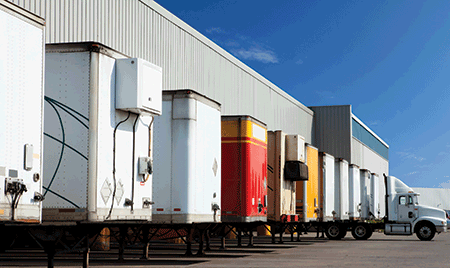Safety on the loading dock
A look at the hazards – and how to mitigate them

Page 2 of 2
In a pocket guide on warehousing safety, OSHA advises employers to place visual warnings near dock edges. Forklift drivers should use extra caution when driving or backing up near drop-offs.
Among forklift operators in 2018, falls to a lower level accounted for 1,030 (13%) of the 7,940 nonfatal injuries requiring days away from work and 16 (18.8%) of the 85 fatalities, according to BLS data and Injury Facts – an online database of safety and health statistics created by NSC.
“Transportation incidents” accounted for about half of the deaths. In its loading dock safety video, the Protective Guarding Manufacturers Association says a forklift incident can cost employers up to $135,000.
“Dock edges are one of the most economical, least difficult areas of a facility to protect,” Consider said, “so it’s best to err on the side of caution. Most of the dock gates and rails that are available are easy to install, require little maintenance, easy to operate and economical to purchase.”
Take control of traffic
Inside facilities, workers on foot – combined with moving forklifts and other material handling machinery – can create hazards, with collisions among the more major issues. Consider’s advice: Assemble a cross-functional forklift safety team that will conduct risk assessments of high traffic areas and then implement actionable solutions.
Workers on foot should wear reflective clothing. Meanwhile, powered industrial truck operators should:
- Inspect the machinery before use.
- Keep forks low to the ground to maintain 360-degree visibility during use.
- Make sure loads are stable and secure.
- Never carry loads that exceed the equipment’s weight capacity. Employers should:
- Create a floor marking system – either with paint or tape – that includes crosswalks and marked zones where forklifts and workers are likely to interact or cross paths.
- Ensure forklift operators are properly trained and all workers complete awareness training.
- Keep people away from forklifts as much as possible.
- Post clearly visible speed limits around the facility.
- Lower the maximum speed on a forklift by installing a speed limiter.
- Use other “automated controls” such as warning sensors, automated gates, backup sensors, cameras and proximity detection devices.
- Install safety gates, guardrails, bollards or other barriers.
Help workers stay safe
Ergonomics is a significant concern. OSHA advises the use of powered equipment whenever possible instead of having workers perform manual lifts. The agency also recommends employers reduce the number of lifts workers make from shoulder height and floor height by repositioning the shelf or bin.
Along with providing task-oriented training on ergonomics, employers should make sure floors are kept clean and free of slip and trip hazards, and overhead lighting is adequate for the work required.

Photo: chemmoo/shutterstock
Health and Safety Ontario, a partner with Workplace Safety and Prevention Services in Canada, has recommendations for shrink-wrapping or assembling loads. Among its advice is to use automated wrapping equipment, if possible, or ergonomically correct tools. If wrapping by hand, rotate workers. The organizations also recommend that skids be wrapped in one specific area and equipment operators are made aware of this area.
Shrink-wrap spools should be light and have wide diameters, and skids shouldn’t be above shoulder height to reduce shoulder and upper back injuries.
Workers also can alternate wrapping directions and techniques.
HSO says workers who use straps to secure loads should wear safety goggles and leather gloves. They should also use metal cutters to remove any excess strapping, sharp or pointed ends, and broken or damaged bands.
When working with strapped items, workers should stay out of the “direct line” of a strap under tension and shouldn’t lift an item by the strapping. They’re also encouraged to face in the “direction of the pull.”
Before cutting a strap, anchor the closest end with a holding device and warn co-workers. When cutting, stay out of the line of recoil. After the strapping is cut, tie it in a knot if it isn’t made of metal; otherwise, fold and flatten it. Throw out any strapping waste immediately to eliminate tripping hazards.
If workers are transporting items that contain chemicals – hazardous or otherwise, employers should make sure the task is done in a well-ventilated area, with the use of vented hoods or local exhaust systems as needed, HSO advises. Proper ventilation is important for another reason, Consider said, because workers or forklift operators may be exposed to carbon monoxide from trucks or forklifts.
Before unloading a trailer, HSO says drivers’ waybills should be reviewed to make sure any product onboard won’t pose a hazard if it leaks. OSHA states that Safety Data Sheets should be maintained for every chemical workers may be exposed to, and that workers should follow SDS instructions for handling chemicals. The agency also advises storing any chemicals away from forklift traffic areas.
Employers also need a written spill control plan. They should provide cleanup kits “in any area where chemicals are stored,” and workers should have the proper personal protective equipment when needed.
Post a comment to this article
Safety+Health welcomes comments that promote respectful dialogue. Please stay on topic. Comments that contain personal attacks, profanity or abusive language – or those aggressively promoting products or services – will be removed. We reserve the right to determine which comments violate our comment policy. (Anonymous comments are welcome; merely skip the “name” field in the comment box. An email address is required but will not be included with your comment.)

